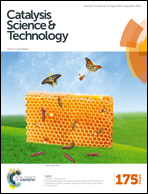Identification of active sites and reaction mechanism on low-temperature SCR activity over Cu-SSZ-13 catalysts prepared by different methods†
Abstract
Cu-SSZ-13 catalysts with similar Si/Al and Cu/Al ratios were prepared by aqueous solution ion-exchange (Cu-SSZ-13-I) and one-pot synthesis (Cu-SSZ-13-O) methods. NH3-SCR tests, XRD, BET, SEM, HRTEM, EPR, H2-TPR, NH3-TPD, NO + O2-TPD, in situ DRIFTS, and kinetic tests were performed for the catalytic measurement, bulk characterization and mechanism estimation. The NH3-SCR results indicated that Cu-SSZ-13-O showed higher DeNOx activity than Cu-SSZ-13-I in the absence or presence of H2O across the entire temperature range. The results of EPR, H2-TPR and NO + O2-TPD showed that more Cu2+ ions existed in Cu-SSZ-13-O, which mainly accounts for the Lewis acid sites and the majority of the NOx adsorption or activation. The DRIFTS results showed that NH3 on Lewis acid sites was more active than that on Brønsted acid sites in the NH3-SCR reaction. Furthermore, the DRIFTS results also indicated that monodentate nitrates are the most active nitrate species. Compared with Cu-SSZ-13-I, Cu-SSZ-13-O showed stronger Lewis acid site strengths and had more abundant monodentate nitrate species. Therefore, the NH3-SCR reaction proceeded more easily over Cu-SSZ-13-O in comparison with Cu-SSZ-13-I. This could be the key factor that explains the more excellent low-temperature SCR activity of Cu-SSZ-13-O. In addition, at low reaction temperatures, Cu-SSZ-13-O was less affected by pore (i.e., intracrystalline) diffusion limitations.


 Please wait while we load your content...
Please wait while we load your content...